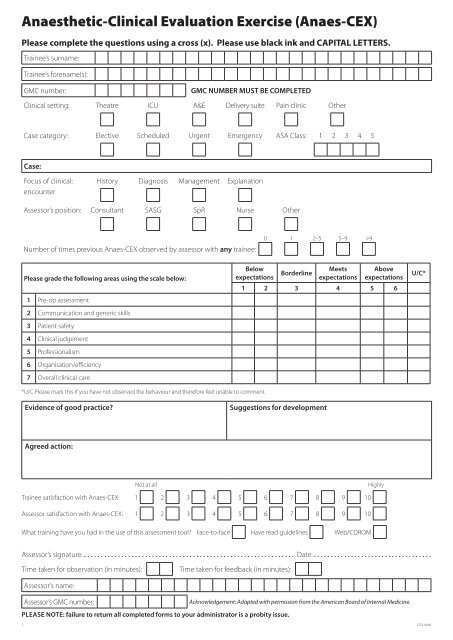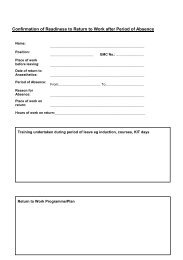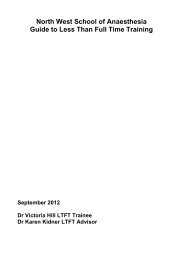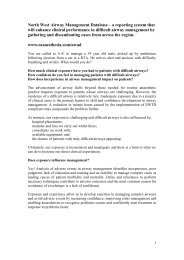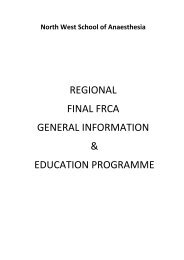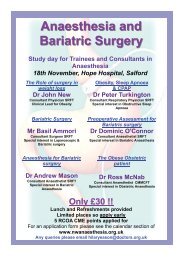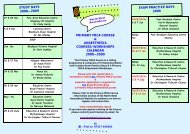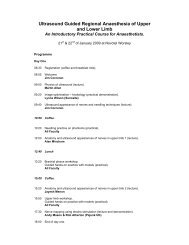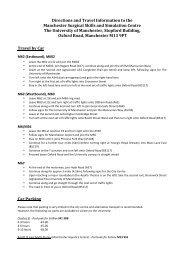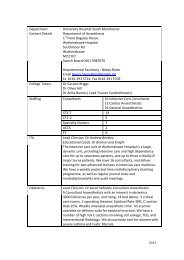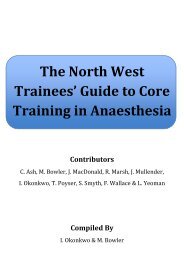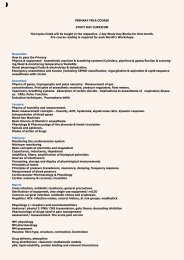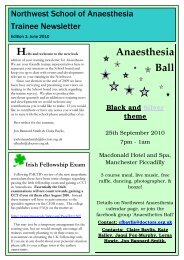Anaesthetic-Clinical Evaluation Exercise (Anaes-CEX)
Anaesthetic-Clinical Evaluation Exercise (Anaes-CEX)
Anaesthetic-Clinical Evaluation Exercise (Anaes-CEX)
- No tags were found...
You also want an ePaper? Increase the reach of your titles
YUMPU automatically turns print PDFs into web optimized ePapers that Google loves.
<strong><strong>Anaes</strong>thetic</strong>-<strong>Clinical</strong> <strong>Evaluation</strong> <strong>Exercise</strong> (<strong>Anaes</strong>-<strong>CEX</strong>)Please complete the questions using a cross (x). Please use black ink and CAPITAL LETTERS.Trainee’s surname:Trainee’s forename(s):GMC number: GMC NUMBER MUST BE COMPLETED<strong>Clinical</strong> setting: Theatre ICU A&E Delivery suite Pain clinic OtherCase category: Elective Scheduled Urgent Emergency ASA Class: 1 2 3 4 5Case:Focus of clinical:encounterHistory Diagnosis Management ExplanationAssessor’s position: Consultant SASG SpR Nurse OtherNumber of times previous <strong>Anaes</strong>-<strong>CEX</strong> observed by assessor with any trainee:0 1 2–5 5–9 >9Please grade the following areas using the scale below:1 Pre-op assessment2 Communication and generic skills3 Patient safety4 <strong>Clinical</strong> judgement5 Professionalism6 Organisation/efficiency7 Overall clinical careBelowexpectationsBorderlineMeetsexpectationsAboveexpectations1 2 3 4 5 6U/C**U/C Please mark this if you have not observed the behaviour and therefore feel unable to comment.Evidence of good practice?Suggestions for developmentAgreed action:Not at allHighlyTrainee satisfaction with <strong>Anaes</strong>-<strong>CEX</strong>: 1 2 3 4 5 6 7 8 9 10Assessor satisfaction with <strong>Anaes</strong>-<strong>CEX</strong>: 1 2 3 4 5 6 7 8 9 10What training have you had in the use of this assessment tool? Face-to-face Have read guidelines Web/CDROMAssessor’s signature:Date:Time taken for observation (in minutes):Time taken for feedback (in minutes):Assessor’s name:Assessor’s GMC number:Acknowledgement: Adapted with permission from the American Board of Internal Medicine.Please note: failure to return all completed forms to your administrator is a probity issue.<strong>CEX</strong>.indd
<strong><strong>Anaes</strong>thetic</strong>-<strong>Clinical</strong> <strong>Evaluation</strong> <strong>Exercise</strong> (<strong>Anaes</strong>-<strong>CEX</strong>)The key learning event in anaesthetic training is the supervised operating list, where management plans are formulated, problemsare discussed, techniques and procedures taught and behaviours learnt. Therefore an operating list, obstetric emergency or ICUadmission is too valuable an opportunity to miss, and so should be fully exploited for occasional use in trainee assessment. The anaes-<strong>CEX</strong> is intended to evaluate the core skills that trainees employ in many clinical scenarios throughout the curriculum. In practice, thisassessment should be undertaken at the trainee’s behest, in a routine operating list undertaken with a consultant or senior trainee (StRyears 6 and 7). The assessor will act primarily as an observer and allow the trainee to manage the major part of the list. The assessor willstimulate dialogue – not in an attempt to gauge depth of knowledge – but more to understand thought processes and managementdecisions made through the course of a procedure or list. The assessor then scores the trainee in each of the seven domains using thestandard form. Feedback and discussion at the end of the session is mandatory.DomainDescriptor1 Pre-op assessment Appropriate questions (including history relevant to surgery)Focuses questions and physical exam on areas of concern/relevance2 Communication and generic skills Patients (including explanation of anaesthesia and opportunities for questions)Medical staffNon-medical staff3 Patient safety ConsentPatient IdentityMachine checksObservational skillsSituational awarenessBlood productsPersonal (gloves and masks etc.)‘Sidedness’ 1Sterile techniqueSharpsDrug labelsElectrical etc4 <strong>Clinical</strong> judgement Use of appropriate techniqueSound management of anaesthesia5 Professionalism RespectCompassionEmpathyEthical mattersAware of own limitations6 Organisation and efficiency OrganisationPreparationMakes efficient use timeAnticipation7 Overall clinical care Synthesis of aboveEffective1Ensuring that the correct ‘side’ is presented to the surgeon when operating on limbs or paired organs and placing cannulae etc,in the non-dominant limb except when that limb to be operated upon.<strong>CEX</strong>.indd


